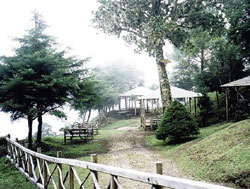
|
|
|
|
|
|
|
|
|
|
|
|
|
|
|
|
|
| Point of Interest |
Enveloped in 'Misty Bliss' Claudia Gardner, Hospitality Jamaica Writer A 'TROPICAL mist paradise', 'misty bliss', 'a gift of nature', and 'a national treasure', describes Holywell, the 25-acre mountain retreat nestled some 3500 feet on the Blue and John Crow Mountains National Park. Holywell, known largely for its misty, cool conditions, is a short distance from Catherine's Peak and Newcastle Training Depot, the cradle of the Jamaica Defence Force. The attraction is about an hour from St. Andrew, and just under two hours from Port Antonio. Holywell offers to its visitors, five nature trails with interpretive signs, namely the Oatley Mountain, Waterfall, Shelter, Dick's Pond and River Trails, in addition to sprawling picnic areas, gazebos, and an educational visitors centre. It also boasts three furnished and fully equipped, rustic, log-cabins at the westernmost end of the property for overnight stays, and for the more adventurous, five camp sites for sleeping under the stars. GREEN DESTINATION
Certified as a "green destination" by international environmental certification organisation, Green Globe last June, Holywell is managed by the Jamaica Conservation Development Trust (JCDT), an environmental non-government organisation, through a co-management agreement with the National Environment and Planning Agency (NEPA) and the Forestry Department. It was once a coffee plantation back in the 1800s, but was taken over by the Forestry Department in the 1960s and later put under the care of the JCDT. The Blue and John Crow Mountains National Park, where Holywell is situated, protects a large percentage of Jamaica's last remaining tropical rain-forest, eight watersheds and sections of St. Andrew, Portland, St. Thomas and St. Mary. It is also home to numerous orchids, bromeliads and ferns, which are found nowhere else in the world and supplies over 40 per cent of the population of Jamaica with potable water. On a trip to Holywell, visitors are likely to see some of Jamaica's native trees including the mountain yacca, the soapwood, milkwood and mountain bullet, as well as some of its over 500 hundred different species of flowering plants of which approximately 50 per cent are endemic. In addition, there are 21 species of tree-ferns in the park, 15 of which are found nowhere else in the island. Anyone who has visited Holywell will confirm that it is a bird-lover's paradise. The area is very important for migratory species such as Bicknell's thrush, black swift and warblers. The 200,000 acre Blue and John Crow Mountains National Park in which Holywell lies, is home to 25 of Jamaica's endemic species of birds, including the Jamaican tody, woodpecker and white-chinned thrush (hopping dick). But, despite all its offerings, Holywell remains relatively underutilized by locals and tourists alike. According to executive director of the JCDT Susan Otuokon, Holywell is bypassed by many of the tour buses, which frequent the area. Annually, just about 7,000 visitors journey on the winding road, which leads to the property, inclusive of the 2,000 who attend Misty Bliss, an annual cultural and entertainment event staged by the JCDT. CONCERTED EFFORT "Tour operators already have their packages, so it is very difficult and it will take time to break in and encourage them to do a different tour, because they already have six or eight in Kingston. We think we can break into the market, but it is going to take a concerted effort and that is why we are actually seeking funds to enable us to have a more focused approach," she told Hospitality Jamaica. One of the newest attractions at Holywell is the Kids Discovery Zone, which was built to facilitate children ages six to eight years old as well as primary school groups. Mrs. Otuokon said this facility is used for bird identification, games and storytelling. "We use eco-tourism principles to manage the site, so there has to be an educational component," Mrs. Otuokon said. In fulfilment of its eco-tourism management plan, the JCDT has integrated community tourism into its product. A full day's tour entails a community component where guests are taken on community tours by youngsters from the community, who participated in the JCDT's community tour-guiding programme held last year. |
All
rights reserved by the Gleaner Company Ltd.
© Gleaner
Company | Produced by Go
Jamaica
Hospitality Jamaica is updated every two (2) weeks
